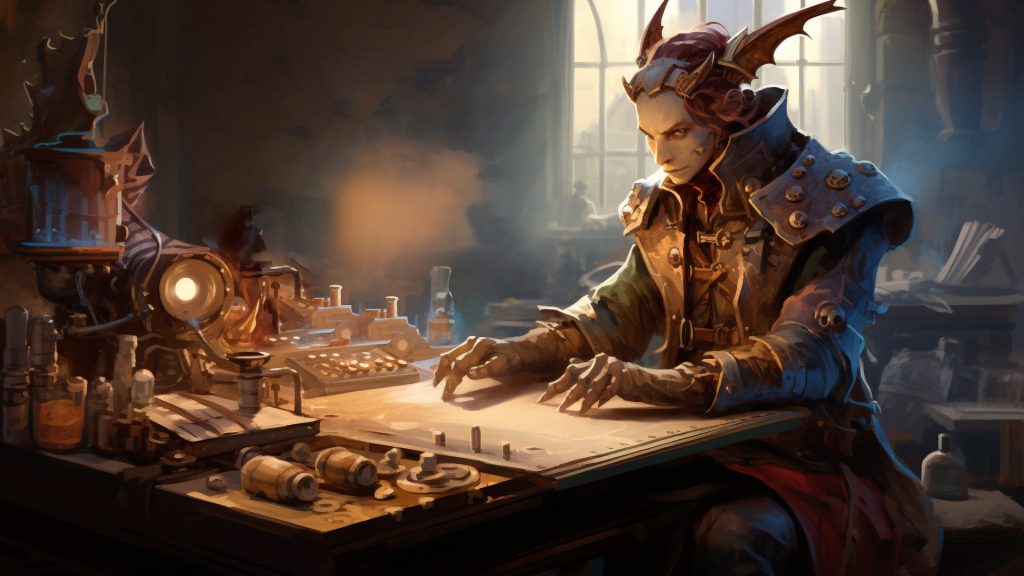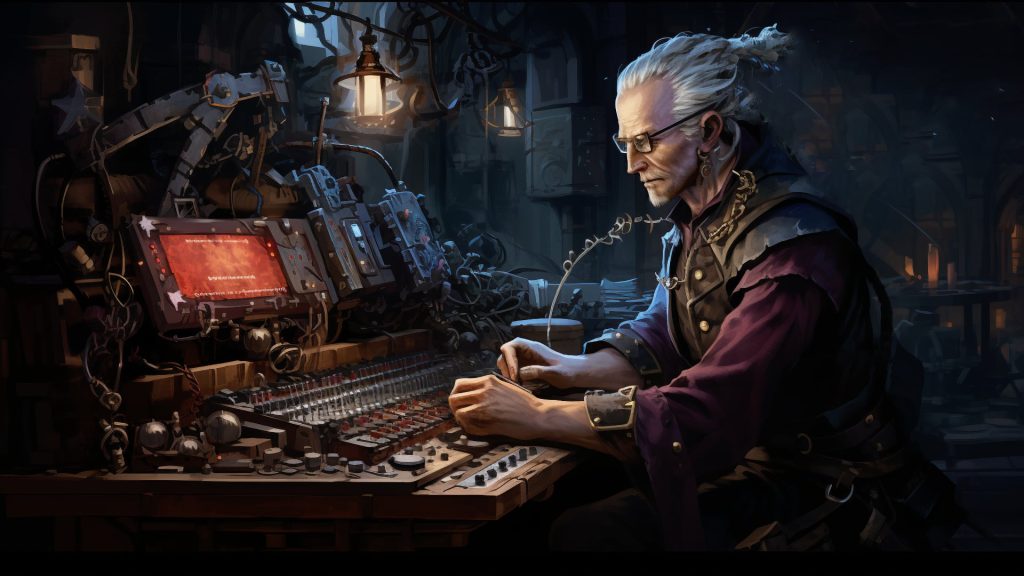You’ve always been fascinated by how things work, analyzing the world around you with a twinkle in your eye and oils stains on your shirt. Now you’re ready to see what problems the world has to offer, and how many attempts it takes you to solve those problems without unintentional explosions. You want to play an Artificer, so grab your goggles, and let’s start the experiment.
In this Artificer DnD 5E guide, we’ll train you on your options as an Artificer, as well as supportive choices you can make to build your character to achieve what you want. Whilst reading through this guide, you may find our articles on DnD terms and list of DnD books (and their common abbreviations) helpful.
This Artificer DnD 5E guide will evaluate each option for the Artificer on a scale of 1-5 — this is a rating of the abilities’ potency and overall usefulness, primarily focusing on combat where appropriate. That said, I will still evaluate everything, hopefully, to aid you to weigh any choices you might be considering at a glance, helping you know what to expect and make changes accordingly if desired. The rating scheme is:
1 – Usually a bad choice, to be avoided
2 – Below average, this can apply to powerful but very niche abilities
3 – Average to Good, you won’t go wrong with it
4 – Very good
5 – Amazing, a must-have if there is such a thing
Be sure to check our other DnD 5E class guides: Barbarian 5E guide, Fighter 5E guide, Monk 5E guide, Paladin 5E guide, Ranger 5E guide, Rogue 5E guide, Sorcerer 5E guide, and Warlock 5E guide.
Changelog
Disclaimer
This rating system exists to best help you understand the effectiveness of all the options available to the class for you to build and enjoy your character. Remember though, your fun comes first; it’s actually very difficult to build a character that is entirely bad in DnD 5E, so if you have a concept that doesn’t rate highly, you might still have fun playing it. This is a guide, not a contract written by Asmodeus. Let it advise you and not force you away from your own ideas.
It’s recommended to have your book/PDF/DnD Beyond page open to reference and follow along with the guide.
Table of Contents
Artificer DnD 5E Class Abilities Guide

Hit Dice 3 – With a middle-of-the-road d8 the Artificer won’t be hurting for hit points, but they won’t be swimming in them either without a good Con mod or other sources of HP.
Proficiencies
Armor 5 – Medium armor and a shield will give you a great base AC, and you have the option of pushing it sky high with infusions. This gets a 5 without heavy armor as that isn’t an armor type that most Artificers will even want, however, the Armorer subclass allows you to use heavy armor without any Strength requirements should you be interested in it.
Weapons 3 – Simple weapons are enough for most Artificers, with each subclass being incentivized to damage enemies in their own ways. It’s a shame that the class as a whole didn’t receive proficiency with heavy and hand crossbows, the mechanical weapons feel right at home with the Artificer.
Tools 5 – Three tools, including the ever-useful Thieves’ Tools, make you the best class at tool use straight from 1st level, with even more tools coming from your subclasses.
Saving Throws 5 – Constitution is a fantastic saving throw for a class with spellcasting, helping you keep concentration on your spells as well as helping you avoid nasty things like poison. Intelligence saves aren’t very common, but they’re usually very bad news to fail when they do come up.
Skills 3 – Middle of the road with only two choices, but the stand-out options of Perception and Arcana.
Magical Tinkering 5 – This is largely a ribbon ability and it excels in that role, giving you the Artificer feel of creating little gadgets whilst scaling with your Intelligence. If you’re looking for practical applications: rolling a ball bearing that creates sound along the floor can be a great distraction for guards, and creating multiple sources of light that you can throw into rooms or drop down holes can be invaluable in a dungeon.
Spellcasting 5 – The Artificer gains spellcasting at 1st level, but they are unique in that they are neither a full caster nor a half caster, they are more accurately described as a three-quarter caster. This is because they get this feature at first level, along with cantrips, but their spell progression more closely matches a half caster, topping out at 5th level spells. It’s also worth noting that when multiclassing an Artificer, you round up your spellcaster level, instead of rounding down with a Paladin or Ranger. This means that a full caster can take a one level dip into Artificer without slowing down their spell slot progression.
Artificers are also unique in needing to cast their spells through artisan’s tools with which they are proficient or an infused item, adding an M component to spells that lack it. This might seem like a clunky drawback at first but actually allows you greater freedom for casting whilst wearing a shield, as you can use the hand holding the focus to perform the somatic component. The spell list for the Artificer is primarily control and utility spells, with some healing spells mixed in, and additional spells provided by the subclasses. As a prepared caster with Ritual Casting the Artificer has access to a wide variety of spells to address different situations, with the only hole in their list being blasting, though this is covered by spells gained by every subclass except the Battle Smith.
Infuse Item 5 – The defining feature of the class, being able to create magic items for yourself, or your party if you’re feeling generous, is a fantastic ability that allows you to plan character builds without relying on the DM’s benevolence. The scaling that comes along with this feature is a combination of more infusions and access to more powerful infusions at higher levels, with some individual infusions getting more powerful at later levels. Note: You will always know more infusions than you can actually use at once, and you cannot learn the same infusion twice. We will review each infusion option later in the guide.
The Right Tool for the Job 5 – A ribbon feature that comes alongside your subclass, this helps ensure that you’ll have the tools that you need without having to pay for them or lug around a giant toolbox. This is a convenience ability that only gets a 5 as it is a bonus to your subclass abilities at this level.
Tool Expertise 5 – Mostly useful for being able to pick locks and disable traps more reliably, this ability helps make sure that whatever you attempt with your tools will go off somewhat smoothly. You gain this thematic feature along with a 3rd infused item, and this is reflected in its rating.
Flash of Genius 5 – An outstanding ability being able to give yourself, or an ally within 30 feet, a fixed bonus to a saving throw or skill check can make the difference between player death or a victory ale down the tavern after the encounter. Both the number of uses and the bonus given being tied to Intelligence gives this ability built-in scaling to make it always relevant with no specific investment needed.
Magic Item Adept 4 – This primarily allows you to more freely use infusions that require attunement, but really shines in campaigns where you have access to multiple attunement items from the DM. The ability to craft magic items cheaper and faster is a nice benefit that suits an Artificer, but will heavily depend on your table for how useful it is.
Spell-Storing Item 5 – This feature essentially lets you turn a 1st or 2nd level spell into almost a cantrip for you, with stand-out options including Cure Wounds for a huge amount of healing, Web for a great control option, and Invisibility so the entire party can sneak into a location. It’s important to remember that you don’t have to be the one using the item, allowing you to pass it off to a party member, familiar, or an alchemical homunculus for use. Depending on your subclass you may have other compelling options available to you, such as a Magic Missile (Armorer) or Shatter (Armorer and Artillerist).
Magic Item Savant 4 – This is much the same as Magic Item Adept, if your party happened to have found a really nice, but class-restricted, item that is now available to you. Whilst this opens up a large number of powerful items potentially, it is entirely dependent on your table.
Magic Item Master 3 – Six attunement slots is impressive, but you may be struggling to fill them without some items from the campaign. With no secondary benefit, this feels very ‘meh’ to anyone who hasn’t been holding onto an item until this level.
Soul of Artifice 5 – A bonus to your saving throws based on your number of attuned items is amazing, especially when those items can also be granting you a bonus. The ability to say no to dropping to 0 HP potentially six times in a day makes you as hard to kill as a high-level Barbarian, just with a higher AC rather than more hit points.
Artificer 5E Infusion Options Guide

The following list of infusions are arranged alphabetically but those under the ‘TCoE only’ section can only be found in that book, whilst the others can mostly be found in both TCoE and E:RftLW. If an infusion has a requirement, such as attunement, it is denoted in [brackets].
Boots of the Winding Path [6th level, Attunement] 4 – Perfect for skirmishing, the only thing holding this infusion back is the need to use a bonus action, on a class with a lot of potential bonus actions to take. This is best for an Armorer using the Guardian form, as they will be making melee attacks but don’t have a regular use for their bonus action.
Enhanced Arcane Focus [Attunement] 5 – This is Wand of the War Mage with a different name, a great item for an Artillerist, or another blasting spell caster in your party, for example, a Warlock that likes to use Eldritch Blast.
Enhanced Defense 5 – Being able to increase your AC is always going to be a great option, the ability to make a shield +1 is particularly nice as it will work with unarmored AC calculations that your or your party may use, such as the Tortle’s flat 17 AC, or the Barbarian’s Unarmored Defense. The scaling to +2 at 10th level helps keep the infusion competitive as monster to hit bonuses increase.
Enhanced Weapon 5 – With resistance and immunity to nonmagical bludgeoning, piercing, and slashing becoming increasingly common as levels increase, access to magic weapons becomes essential. Being able to give yourself, or a party member, a +1 weapon that will later become a +2 weapon is great. There is a caveat here, that between levels 6 and 10 you should use either Radiant Weapon or Repeating Weapon, as this will give you a +1 weapon with a secondary benefit.
Homunculus Servant [6th level, a gem worth at least 100GP] 4 – This is a mechanical companion that any Artificer can use, it can provide a weaponized bonus action for Alchemists and Armorers. The only thing holding this back is the low AC and HP, but the ability to repair it with Mending helps mitigate this.
Radiant Weapon [6th level, Attunement] 5 – A +1 weapon that doubles (neigh, triples!) as a light source and retributive reaction. This infusion gives you a lot of value, with the reaction being a great option to punish the bad guys for picking the wrong PC to hit.
Repeating Shot [Attunement] 5 – Not having to worry about ammunition is nice, but where this infusion shines is with the Battle Smith that can use a heavy crossbow for higher damage, or a hand crossbow with a shield for higher AC.
Replicate Magic Item 5 – There’s a lot of potential here, but the specific magic item determines the rating, so we will now go through each option:
- Alchemy Jug [2nd level] 4 – Whilst not the most mechanically effective option, it’s one of the most fun and you can never underestimate having a near-unlimited supply of poison and mayonnaise.
- Bag of Holding [2nd level] 5 – An iconic item that can be invaluable when you need to haul large amounts of treasure or hide your Steel Defender and Alchemical Homunculus from watchful guards.
- Cap of Water Breathing [2nd level] 3 – This is a niche item, but the fact that it doesn’t require attunement makes it really appealing, it allows you to approach situations with an entirely different mindset… as long as there’s water, of course.
- Goggles of Night [2nd level] 4 – A relatively cheap and easy way of fixing your lack of darkvision problems, this only gets a 4 as the Artificer does get access to the Darkvision spell.
- Rope of Climbing [2nd level] 3 – A good way around some environmental challenges when flight is not available, or too expensive to be practical.
- Sending Stones [2nd level] 5 – An excellent magic item that greatly expands your party’s tactical abilities. If you’re going to split the party, you may as well hand out the walkie-talkies first.
- Wand of Magic Detection [2nd level] 2 – An okay item if you don’t want to prepare it or spend additional time casting it as a ritual, but when you already get it as an Artificer spell it’s hard to rate this highly.
- Wand of Secrets [2nd level] 3 – Whilst this is a bit niche, traps, and secret doors are a staple of Dungeons and Dragons and this could save a PC’s life, maybe.
- Boots of Elvenkind [6th level] 3 – These boots definitely help you be stealthier, but you’ll still need a way to not be seen, invisibility pairs well here but is expensive for you to cast until you get Spell Storing Item.
- Cloak of Elvenkind [6th level, Attunement] 4 – A larger bump to your stealth than its footwear cousin in most scenarios. Bonus points if you theme it as the Predator cloaking.
- Cloak of the manta ray [6th level] 4 – A cheap and easy way of dealing with any aquatic environment, if you were using the Cap of Water Breathing before, you should replace it with this when you level up unless you already have a magical cloak. This doesn’t warrant a 5 as it is still niche.
- Eyes of Charming [6th level, Attunement] 3 – This gives you access to Charm Person, which isn’t on the Artificer spell list, but with only a DC of 13, it’s only okay at best.
- Gloves of Thievery [6th level] 4 – This rating is primarily based on the bonus to picking locks, the +5 pairs excellently with your Expertise in Thieves’ Tools to make you an extremely reliable lockpicker. Move over Rogues below 11th level.
- Lantern of Revealing [6th level] 1 – A very niche item that’s difficult to justify when you can just prepare the See Invisibility spell.
- Pipes of Haunting [6th level] 1 – You can’t use this without gaining proficiency with a wind instrument from your background or elsewhere. Even if you qualify it’s a 30ft radius centered on you that can affect your allies, a neat item but not worth the trouble.
- Ring of Water Walking [6th level] 2 – A fun item that would work great with your Naruto cosplay, but niche in practical use.
- Boots of Striding and Springing [10th level, Attunement] 2 – Best for races with a 25ft movement speed, the ability to jump really far/high is fun but likely won’t come up often.
- Boots of the Winterlands [10th level, Attunement] 2 – This is basically just resistance to cold damage unless you’re playing in a campaign like Icewind Dale: Rime of the Frost Maiden.
- Bracers of Archery [10th level, Attunement] 3 – Not bad for a Battle Smith that can combine it with Extra Attack and a +1 longbow, or handed off to a dedicated archer party member. A good item that delivers a damage bump when it could be needed, but not an exciting or a big increase.
- Brooch of Shielding [10th level, Attunement] 1 – One of the few ways to protect yourself against Magic Missile, but both that spell and force damage, in general, aren’t likely to be common enough for this to be worth it.
- Cloak of Protection [10th level, Attunement] 5 – A bonus to both your AC and all saving throws, an excellent item that will stack with your already high AC and Flash of Genius.
- Eyes of the Eagle [10th level, Attunement] 2 – Advantage on Perception checks is very nice, but it won’t help you on checks related to anything that doesn’t rely on sight and an infusion is a significant investment.
- Gauntlets of Ogre Power [10th level, Attunement] 2 – Bumping a stat to 19 is great, that stat being Strength isn’t so great, but it opens up some different options. If you’re a Battle Smith, you may want to consider giving them to your Steel Defender, for example.
- Gloves of Missile Snaring [10th level, Attunement] 1 – There’s potential here for this item to give you a solid defense against ranged attacks if you’re a ranged Artificer. However, this won’t protect you from a spell attack which is fairly common as a ranged option for monsters. As you’re spending an infusion and an attunement slot for this item, it really isn’t worth it to protect you only against some damage from some ranged attacks.
- Gloves of Swimming and Climbing [10th level, Attunement] 1 – A terrible option, you’d be better off at this level taking Cloak of the Manta Ray and preparing the Fly spell.
- Hat of Disguise [10th level, Attunement] 2 – This is the equivalent of a Warlock’s Mask of Many Faces invocation in hat form, this can be really fun to play with, and allows you to be very effective in infiltrating hostile areas. This only gets a 3 as you can prepare Disguise Self if you need to, and 10th level is fairly high to pick this up, making it more likely that the bad guys might have countermeasures against illusory disguise. If you are really interested in this, then consider using Disguise Self with Spell Storing Item.
- Headband of Intellect [10th level, Attunement] 3 – The appeal of this item is allowing you to take feats or bump other stats with one, or both, of your ASIs whilst knowing you can still pump your Int to 19 at 10th level. The freedom this grants you warrants a 3, but in reality most Artificers aren’t going to want to wait until 10th level to get a +4 Int, especially with the excellent Flash of Genius tied so heavily to it.
- Helm of Telepathy [10th level, Attunement] 1 – There are better ways to get telepathy, and the spell save DC is so low that you won’t get much use out of it on non-allies.
- Medallion of Thoughts [10th level, Attunement] 1 – If you really want Detect Thoughts you can get more bang for your buck with the Helm of Telepathy above, or you can just take the Telepathic feat and get a higher spell save DC for it.
- Necklace of Adaptation [10th level, Attunement] 2 – Being able to breathe anywhere, and a situational defence is nice, but if you want a niche item like this then you’ll be better off with the Venitlating Lung below.
- Periapt of Wound Closure [10th level, Attunement] 2 – I’m going to optimistically rate this a 2 for being niche, hopefully, no one in your party needs this but it can come in handy in more lethal campaigns, or those using alternate rules that makes Hit Dice healing more valuable.
- Pipes of the Sewers [10th level, Attunement] 1 – A whimsical item, but you lack the proficiency to use it and it is too likely to not work. You require enough rats in the local area, as well as the needing to win a contested ability check.
- Quiver of Ehlonna [10th level] 1 – A neat item, but you shouldn’t be worrying about carrying ammunition and additional weapons at 10th level and beyond. If ammunition is a concern you can just refill a normal quiver/bolt case from a Bag of Holding at a much earlier level.
- Ring of Jumping [10th level, Attunement] 1 – If you want to jump further you’re better off choosing the Boots of Striding and Springing, if you want to combine the Jump spell with the boots, then you’re better off just preparing Jump as one of your spells for the day.
- Ring of Mind Shielding [10th level, Attunement] 1 – A very thematic item, it may prove useful in certain games but its benefits are incredibly niche.
- Slippers of Spider Climbing [10th level, Attunement] 3 – Who doesn’t want to become an all-terrain Artificer? This greatly expands your mobility as an always-on effect.
- Ventilating Lung [10th level, Attunement] 3 – Gust of Wind, the ability to breathe underwater (or anywhere), and advantage against poisonous gases gives a nice package. An interesting option that you can have fun with, even if it isn’t the most mechanically efficient option.
- Winged Boots [10th level, Attunement] 5 – An excellent way to fly without needing to use your limited spell slots and precious concentration. The time restriction shouldn’t hinder you unless you attempt to use the boots for long-distance flights, instead of just combat and environmental challenges.
- Amulet of Health [14th level, Attunement] 4 – Raising your Con at this level gives you a dollop of hit points and a boost to your Con saving throws, which can be great boosts on their own. However, how much you get out of this item depends on your current Con score, if you have a 16/17 then this won’t be as much benefit to you the same way it would if your Con score was 14. This may be able to significantly help a party member, if you feel like sharing that is.
- Arcane Propulsion Arm [14th level, Attunement] 2 – Rocket punching people is fun, but not particularly effective, best for shield using Battle Smiths.
- Belt of Hill Giant Strength [14th level, Attunement] 3 – Being able to max a stat is a very potent effect, however, this only gets a 3 as those that really benefit from a high Strength will already have it. Powerful but niche is a good way to sum this up.
- Boots of Levitation [14th level, Attunement] 1 – Worse than Winged Boots in much every way.
- Boots of Speed [14th level, Attunement] 4 – If you want to play, or help a party member play, a skirmisher then this is a great item. The combination of disadvantage on opportunity attacks with an Artificer’s high AC means you won’t get hit often and the increased speed allows you to retreat to safety.
- Bracers of Defense [14th level, Attunement] 4 – Excellent item for unarmored characters, such as Monks, some Barbarians, and Tortle Artificers. For those it applies to this is a powerful item, however, it is entirely possible that no one in your party may be able to use this item so it doesn’t quite hit a 5.
- Cloak of the Bat [14th level, Attunement] 4 – There are a lot of abilities on offer here, but the restriction of needing both hands to fly and dim light or darkness for both flying and turning into a bit makes this item too unreliable for a 5.
- Dimensional Shackles [14th level] 1 – If you’re looking to bring a BBEG to justice, then these might be a good pick, however, unless your game requires capturing bad guys with the ability to teleport regularly this is best skipped.
- Gem of Seeing [14th level, Attunement] 3 – Truesight can be very valuable but is entirely dependent on how many shapechangers, illusions etc. are in your campaign.
- Horn of Blasting [14th level] 1 – You might think that this is a cool item, but looks can be deceiving. With Constitution typically a strong save for monsters, a mediocre amount of damage for the level you get it, and a 20% chance it can blow up in your face and kill you. Well, you get the idea.
- Ring of Free Action [14th level, Attunement] 2 – Potentially a very useful item, this is another one that depends entirely on the type of game you’re playing in. Paralyzed and restrained are nasty conditions, but there are plenty of nonmagical ways they can be forced upon you.
- Ring of Protection [14th level, Attunement] 5 – +1 to your saves and AC will always be relevant, this will stack with the Cloak of Protection, or can be used instead of it if you are interested in a different cloak.
- Ring of the Ram [14th level, Attunement] 4 – A decent ranged damage option with some control built-in and the flexibility to try to damage objects. This is a good item to replicate, the only thing holding it back from being a 5 is the relatively low number of charges, and the to hit bonus, which is low compared to your own to hit at 14th level and beyond.
Repulsion Shield [6th level, Attunement] 5 – A +1 AC combined with the ability to push back an attacker up to 4 times a day. This gets a 5 as the push doesn’t require a save, and 15 feet is far enough back that a monster may not be able to get back to you that turn.
Resistant Armor [6th level, Attunement] 2 – Damage resistance is a potent defense, and the ability to select the resistance this armor has when you infuse it means that you can change the damage type daily. However, unless your campaign has a particular type of damage as extremely common, this item is very niche and there’s a good chance you might prepare the wrong damage type for any given day.
Returning Weapon 5 – If you’ve ever wanted to play a knife-throwing character this is a great way to do so, gaining a +1weapon and the flexibility to use short-ranged attacks as you please. This can allow you to skirmish as you please with a spear and shield, or flesh out a throwing concept that would normally struggle with action economy, or having enough magical weapons.
TCoE Only Infusions
Arcane Propulsion Armor [14th level, Attunement] 1 – The concept of this is cool, anyone can be Iron Man! Unfortunately, the reality falls far short with the benefits on offer being very meager for the level and attunement requirements. If the gauntlets were +1 weapons and/or allowed you to use your Intelligence then this would be more appealing. This is best for Battle Smiths and Armorers using the Infiltrator Armor Model. Some DMs may allow the gauntlets to combine with the Guardian’s Thunder Gauntlets, but this interaction is a little grey and up to DM discretion.
Armor of Magical Strength [Attunement] 2 – Whilst niche, this armor infusion has a clear appeal to a certain playstyle: grappling. Being able to add your Int mod to a Strength check to grapple or shove a creature can greatly improve your overall success at that tactic.
Helm of Awareness [10th level, Attunement] 5 – In practice, this is most of the Alert feat in an infusion and that’s fantastic. The level restriction feels unnecessary, but at this level you have four infused items, making this hard to pass up.
Mind Sharpener 5 – Between your Con mod and proficiency in Con saves you’re not very likely to fail most saves to maintain your concentration. When you combine that with being able to choose to succeed up to 4 times a day, you may never lose concentration through damage again! Assuming you’re not exceedingly unlucky, that is.
Spell-Refueling Ring [6th level, Attunement] 4 – This is essentially a Pearl of Power in ring form, this can give your fullcasting allies a lot of extra power for a few levels, but will be more relevant to you for longer due to your slower spell slot progression.
It should also be noted that you are able to replicate common magic items, which allows you to create interesting choices such as the Clockwork Amulet (XGtE) and a Spellwrought Tattoo containing a cantrip or first level spell.
Artificer DnD 5E Stats Guide

No matter which subclass you choose you will be able to rely almost entirely on Intelligence as your primary stat, unless you are multiclassing or using a weapon primarily, but aren’t a Battle Smith. This Int dependence means that maxing your relevant stats is easy and relatively quick, allowing you plenty of ASIs to pick up any feats that interest you. As most Artificers will be relying on medium armor you’ll want a decent score in both Dexterity and Constitution, but Strength, Wisdom, and Charisma can be done to taste.
For a typical Artificer starting with an Int of 16, Dex of 14, and Constitution as high as you can afford will give you a solid base for your character.
Strength 1 – You have no real use for this stat at all, feel free to dump this as low as you can unless you plan on a grappling build, in which case try to not go below 10.
Dexterity 4 – Some Dexterity is essential for your medium armor, but as Dex is tied to many useful aspects of the game, going higher than 14 won’t go to waste if you can afford to. If you do have a score of 16 you can also use that for your AC by taking the Medium Armor Master feat, and even if you are an Armorer you would be best served by having a positive modifier in Dex.
Constitution 3 – Con isn’t as important to Artificers as other casters, as they have proficiency in Con saving throws to help maintain concentration on spells. That said Con is important for all characters and multiple Artificer options are incentivized to be in melee, so it’s recommended to have this stat as high as you can afford to.
Intelligence 5 – The stat that not only does your spellcasting and abilities key off of, but directly determines how many uses of Magical Tinkering and Flash of Genius you get. The skills attached to Int aren’t always the most useful but can be a weakness for a party lacking a Wizard, allowing you to provide potentially valuable coverage. This stat should be maxed out as soon as possible ideally, but if you choose to delay your Int progression, or not max it out at all, then try and get to a +4 at least first.
Wisdom 3 – Always useful for Perception and Wis saving throws, try and have a +1 here if possible, but with access to Flash of Genius and Guidance, this isn’t as big of a priority for you as other classes.
Charisma 2 – This is entirely down to your character concept: do you want to multiclass into a Cha-focused class? How good at social skills do you want to be? Anything from 8 to 14 is generally recommended as long as it doesn’t cut into your essential stats.
Artificer DnD 5E Specialists (Subclasses) Guide

Your playstyle will be largely, if not entirely, dictated by your subclass choice as the features and spells they impart are incredibly influential game-altering for you. No matter the subclass you choose, you will be able to focus on Int as your primary stat, with minor consideration to your other stats. For example, Armorers don’t need Dex nearly as much, and both Guardian Armorers and Battle Smiths may want higher Con to be in melee. As highlighted in our Artificer DnD 5E guide, the subclass you choose will significantly shape your playstyle, determining your role within the party and providing unique abilities and spells to support your character concept, for example, if you want to be a healer you are likely best being an Alchemist, but if you want to recreate Iron Man then Armorer would be what you want.
Alchemist
This Artificer focuses on potions, possets, and poultices with their offense provided through acid, fire, necrotic, and poison damage. This subclass is the most geared towards healing, with access to some spells not otherwise available to the Artificer, and a bump to healing done. This subclass is commonly regarded as the weakest, or generally suboptimal, choice but don’t let that deter you from this subclass if it catches your attention. The Alchemist is capable of being competitive in damage whilst delivering substantial healing at the same time.
Tool Proficiency 5 – Besides the thematic support of an Alchemist needing to know how to use their own tools, there’s the bonus of being able to craft items including acid and alchemist’s fire (XGtE rules on tool proficiencies) to hurl at your enemies with the Catapult spell.
Alchemist Spells 4 – The offensive spells on offer here aren’t great, but all will work with your 5th level feature for additional damage. The stand-out spells here are Healing Word, Mass Healing Word, and Death Ward allowing you to fulfill the healer role effectively should you wish to. Tip: You can use Healing Word as your bonus action and your offensive cantrip of choice, such as Acid Splash, with both being boosted by Alchemical Savant. Healing Word becomes an effective spell for more than just picking up a downed party member in your hands.
Experimental Elixir 3 – This feature can be incredibly useful, provided you are aware of the drawbacks: the random nature of your free elixir and the lack of scaling built into the options themselves. The effects are mostly useful at all levels, but the amount of HP restored by the Healing effect becomes disappointing at higher levels. This ability is a worthwhile use of some of your 1st level spell slots, with the effects being able to give useful boons to allies without the normal hiccup of concentration. Some examples for how to use this ability include giving an elixir of Boldness to a Sharpshooter or Great Weapon Master using martial or a fullcaster that likes to use their concentration, an archer using Flight to gain the high ground, and a skirmisher making use of the Swiftness effect. It should be noted that this ability receives a huge bump from Restorative Agents at 9th level.
Alchemical Savant 5 – This ability not only keeps your damage competitive but makes you a capable healer, you’re even better at using Healing Word than a Life Cleric! The only downside here is needing to have Alchemical Supplies in hand, which just means that you can’t benefit from your own Enhanced Arcane Focus infusion.
Restorative Agents 5 – You no longer need to prepare, or risk not preparing, Lesser Restoration and the free castings should, hopefully, be more than enough for your party’s needs. The meat of this feature, and most of that 5 rating, is the 2d6 temporary hit points for those that drink your Experimental Elixirs. At this level, you have two free elixirs per long rest, and the temporary hit points will last until the drinkers finish a long rest unless depleted first.
Chemical Mastery 5 – Access to Greater Restoration and Heal fully cement your healer credentials, whilst the resistances offered are a nice thematic bump to your defenses. Part of the rating is due to giving you access to a spell level you wouldn’t normally gain through your Spellcasting feature.
Armorer
The answer to your Iron Man fantasies, this Artificer focuses on enhancing heavy armor to allow the Artificer to take on a more tank-like or skirmishing role. You’re able to switch between these roles, but if you plan to focus on one armor model more than the other, it’s best to consider how to support that model with your overall build. For example, you may want to invest in a higher Con score for the Guardian model, whilst you may want to find a source of Expertise in Stealth for the Infiltrator model.
Tools of the Trade 5 – Proficiency in heavy armor is essential for this subclass to function, whilst proficiency in Smith’s Tools is both thematic and can allow you to craft or repair your armor if you need to.
Armorer Spells 4 – Ideally this list would have included the Shield spell, but the spells on offer here offer a nice mix of blasting, defense, and utility. It feels like the limit of two spells per spell level was a bit stretched in trying to cater to the two different armor models. Stand-out options on the list include Magic Missile, Shatter, Hypnotic Pattern, and Greater Invisibility.
Arcane Armor 5 – This feature is providing mechanical support to the theme of being reliant on magical armor, rather than being the meat of your features, but it does provide nice benefits. Being able to don or doff your armor as an action means that you need not fear being ambushed whilst you sleep, and the ability to use your armor as a focus means that your hands are free to load up with other gear or use as weapons.
Armor Model – To give a more accurate rating the armor models will be rated individually:
Guardian 4 – The Thunder Gauntlets are an outstanding tanking weapon, allowing you to eventually engage multiple monsters and incentivize them to target you, not your robed allies. The bonus action temp HP helps increase your durability, but in earlier levels doesn’t feel like it’s enough, incorporating your Int modifier into either the formula or number of uses would help to alleviate this problem, but as written holds this model back from achieving a 5, along with the Thunder Gauntlets not gaining a direct damage increase in later levels.
Infiltrator 5 – Increased mobility, advantage on Stealth to cancel out the disadvantage heavy armor brings, and a ranged weapon that doesn’t require a hand to use are all excellent. The damage for the Lightning Launcher isn’t particularly high, but it is enough to keep you competitive and is compatible with options like the Sharpshooter feat and Archery Fighting Style. It’s advised to carry a weapon, such as a dagger or a shortsword, in case a monster gets within five feet of you unless you have the Crossbow Expert or Gunner feat (the latter is preferable for this Artificer).
Extra Attack 5 – The damage bump you need, when you need it! This is a staple for most martials and keeps the Armorer relevant in a damage capacity. This also allows the Thunder Gauntlets to affect multiple monsters each turn, making them a much more effective tanking tool.
Armor Modifications 5 – This feature is essential for an Armorer’s power progression and two additional infused items don’t fail to deliver. It’s advisable to plan your learned infusions in the run-up to this feature, so you can properly equip yourself with your various Arcane Armor slots.
Perfected Armor 5 – Great capstones that encompass the playstyle of each armor model. The Guardian’s ability to pull creatures closer to them is excellent for control with the potential for an additional attack, being able to affect creatures up to and including Huge gives excellent coverage here. The Infiltrator’s ability not only has the potential to increase your, or an ally’s, damage but also increases your defenses. The only downside is that creatures immune to lightning damage will not be affected at all, but this is a very small subset of monsters.
Artillerist
Do you want to blast your foes into ash? Does the idea of an arcane gunslinger, or turret deploying engineer interest you? Then look no further, this is the subclass for you with a focus on offensive magic and the option to become an almost unparalleled temp HP generator. This subclass could benefit significantly from the Elemental Adept feat, as a significant amount of its arsenal is fire damage.
Tool Proficiency 5 – Not generally a very useful toolset, but besides being necessary for your Arcane Firearm it also allows you to create a staff, rod, or wand from scratch if you get caught without.
Artillerist Spells 5 – One of only two Artificer subclasses to gain access to Shield, there are plenty of blasting options across all spell levels so that you never get left behind. Both Scorching Ray and Shatter will be excellent options for Spell Storing Item, allowing you to pump out a significant amount of damage over the course of the day.
Eldritch Cannon 5 – Your hallmark feature this gives you three different options to fulfill your role, each doing an excellent job. The Protector cannon can give your party a staggering amount of temporary hit points, as long as they keep a tight formation in combat. With a duration of an hour, it’s reasonable to expect to have your cannon already summoned most of the time, but to ensure that it is available for all combats you will likely need to invest some spell slots. Note: whilst guidance on AC and saving throws are provided, the Eldritch Cannon is not a creature.
Arcane Firearm 4 – A chunk of damage on top of your blasting spells, this is a significant bump initially but doesn’t age very well in later levels. At minimum, this means that your cantrips are more useful as an at-will attack and your blasting spells will effectively be cast a level higher than the slot you spent on them. This does make getting a critical hit on a Fire Bolt feel great though!
Explosive Cannon 3 – The 1d8 damage increase to the Flamethrower and Force Ballista is needed to keep them relevant into tiers 3 and 4, but the detonation ability feels like an odd add-on. The AOE damage you gain from detonating your turret is very minor compared to the bonus action damage you can get from it, making it a last-ditch option at best when you can’t afford another round.
Fortified Position 5 – Half cover is a huge defensive boost and two cannons not only means a huge damage increase but the ability to use both an offensive option and the Protector turret. This also makes the detonation gained from Explosive Cannon more appealing as you will still have one turret left for bonus action use. Note: Explosive Cannon only detonates one cannon by RAW, your DM may rule you can destroy both.
Battle Smith
The most martial subclass, the Battle Smith gives the Artificer the proficiency to use martial weapons and use magic weapons with their Intelligence as well as a faithful mechanical companion. The flavor of the subclass establishes them as somewhat of a combat medic with strong Paladin vibes, although mechanical support isn’t provided until 9th level. If you want to play a weapon using Artificer this is your best choice, and if the Steel Defender is your most powerful option for playing a beast master-style character compared to the Homunculus Servant.
Tool Proficiency 4 – Smith’s Tools aren’t the most generally useful toolset and unlike the Armorer it doesn’t quite as thematic, but the more tools the better!
Battle Smith Spells 4 – An overall great list that channels clockwork Paladin imagery, but the smite spells are what holds this back from a 5. Requiring a bonus action to set them up directly conflicts with using one of your core subclass features, your Steel Defender.
Steel Defender 5 – This construct ally provides a significant damage increase and protects the party through both its Deflect Attack ability and being an additional bag of hit points for monsters to target. Between its Repair ability and the Artificer’s ability to heal it with the Mending cantrip, or revive the Steel Defender altogether with a spell slot, you can safely count on having the Steel Defender for most combats. Note: Your Steel Defender can attune to magic items you can create with your infusions, and if it has appropriate anatomy, can serve as a mount for small Artificers.
Extra Attack 5 – An essential tier 2 damage boost for almost every martial, yes Rogue you’re special, and very much needed for the Battle Smith.
Arcane jolt 5 – An Artificer version of Divine Smite that, whilst limited to once per turn, can be triggered from either the Battle Smith’s attacks or the Steel Defender’s attack and has the option to heal instead of damage. The (up to) five uses is enough to make a difference, but few enough that you need to consider when is best to use them and 2d6 is enough damage, or healing, to potentially turn the tide in a fight.
Improved Defender 5 – An across the board improvement to you as a Battle Smith, with the Arcane Jolt buff making it feel more impactful in late-game D&D and the combination of AC increase and damage to your Steel Defender keeping your metallic friend a force to be ignored at your enemies’ peril.
Artificer DnD 5E Race Choices Guide

Races are good places to pick up abilities for certain character concepts, so if you’re thinking about playing an Artificer build but that race isn’t rated well here, it doesn’t mean your particular combination wouldn’t work or be fun to play. Like I said previously, it’s actually pretty difficult to make a truly bad character in 5e.
Here are some examples of strong race choices for an Artificer:
High Elf 5 – The Dex bump is useable with your medium armor, Perception is a great skill to have, and Fey Ancestry is a decent defensive feature. The impact of Trance will be dependent on your table, and there’s not much in the core race to support an Artificer specifically, solid but not exceptional but mostly dependent on the subrace. An Intelligence bump, an Int-based cantrip for your cantrip-starved class, and even some martial weapon proficiencies for non-Battle Smith Artificers that want to attempt some traditional combat.
Stout Halfling 4 – Dex is useful for you, with the Luck and Brave features being strong enough to overcome the slower movement speed and downsides of being small. Everybody wants more Con and Poison is so prevalent a damage type that Stout Resilience can be a very valuable feature. Battle Smiths can also take advantage of the small size to ride their Steel Defenders.
Variant Human PHB 5 – Bump your Int and another stat of your choice, grab whichever skill interests you, and a free feat at first level! A very potent race option that makes feat-heavy builds more viable for most campaigns.
Warforged 4 – +1 AC, good stats, a skill and tool of your choice, poison resistance, and Sentry’s Rest? A really good but not quite great mechanical option for an Artificer, however, there is a certain charm to a construct making other constructs.
Artificer DnD 5E Feats Guide

As discussed in our comprehensive Artificer DnD 5E guide, the Artificer is mostly a SAD class in terms of what you’ll want to spend your ASIs on as if you can start with a 14 Dex and a decent Con you’ll likely just want to increase Int only. This gives you quite a bit of freedom with your 5 ASIs, but as most of them come in levels that aren’t often played, if you want to take a feat earlier on it’s recommended to be a variant human or at least get your Int to 18 first.
Here are some examples of strong choices for an Artificer:
Ritual Caster 4 – You’ll automatically qualify for this feat and it will allow you to pick up a lot of utility that won’t eat into your spell slots, who wouldn’t want an Unseen Servant in the workshop? You can already cast Artificer spells as a ritual if they have the tag, so use this as an opportunity to grab utility spells the Artificer list lacks, maybe even a familiar if you want one.
Tough 4 – More hit points is always a great option, and with a high AC those hit points will last you longer than they would for a lot of other classes. This is most appealing to tank Artificer builds.
Elven Accuracy [Elf or Half-Elf] 5 – A powerful feat that allows you to bump Int whilst gaining super-advantage, this is great for an Artificer in particular, because you can use a Homunculus Servant, Steel Defender, amongst other tricks, to gain advantage easily.
Fey Touched 5 – Increase your Int, whilst grabbing Misty Step and a 1st level spell? This is an excellent feat to pick up whilst increasing your Int.
Telekinetic 4 – Invisible Mage Hand is a great bit of utility, the push offers a nice amount of control but will likely clash with other bonus actions depending on your build. What carries this to a 4 is the ability to build it into your Int progression.
Artificer DnD 5E Multiclassing Guide

In this section of our Artificer 5E guide, we’ll review each class in terms of how well they multiclass with Artificer, mentioning how many levels and what subclass (if any) would work best. The ratings take multiclassing prerequisites into consideration; if a multiclass will require you to have a 13 in a stat other than Int, it will likely receive a lower score unless the stat is one you would already have at 13 or higher, for example, Dexterity which you need for your AC.
General multiclass tips for the Artificer:
- Consider if the class you’re dipping into requires a high investment in another stat to get a lot out of it, for example, the Bard would require you to have a higher Charisma score in order to have a decent number of Bardic Inspiration dice.
- As an Artificer it’s very easy to have multiple things competing for your bonus action, such as subclass features, spells, and infusions. Whilst this doesn’t apply to all Artificers, it’s worth thinking about any bonus actions your multiclass may give you and how often you can, or would want, to use them. An occasional bonus action like a Fighter’s Second Wind is a lot easier to fit into your action economy than one that you may want to do every other round.
- When grabbing spells from other spellcasting classes, think about why you want that spell and how it will interact with your class features. You can only use tools and infusions as a focus for Artificer spells, likewise many abilities that interact with spells directly specify that they have to be an Artificer spell. An example of this is the Artillerist’s Arcane Firearm.
- Think about what kind of Artificer you are and then aim to get abilities that will support or reinforce your chosen role, this can mean grabbing more healing abilities if you like to heal your allies, or additional sources of damage if you want to put down monsters as quickly as possible. Note: Being a generalist is a role, if you just want to cover as many things as possible with your character then look at what you can’t do, and how a certain class might enable those things for you.
- Plan ahead where you want to take your dip, the Artificer class doesn’t have many/any clear break-off points to start taking levels in another class. At minimum, you should wait until you have your subclass, but ideally after 5th level to ensure that you have your tier 2 damage boost.
- If you just want a certain class for more spellcasting, consider whether or not you could achieve similar results by taking a particular race or feat, this would help preserve your overall Artificer progression in comparison to taking a dip.
- With the exception of some Fighting Styles and abilities, like Second Wind and Action Surge, dipping into martial classes is primarily only advised for Battle Smiths and Armorers as there is much less value for Artificers more dependent on spellcasting.
Barbarian 1 – A class that is focused on the otherwise completely unwanted by you Strength, the prerequisite is a little hard to swallow and Rage shutting down your spellcasting is a big blow to your normal routine. This is best a roleplay choice taken with a Guardian Armorer or Battle Smith, remember that to gain a lot of the benefits of being a Barbarian you actually need to use Strength as your attacking stat. If you go far enough for a subclass at third level, then Path of the Totem Warrior choosing the bear for resistance to all damage but psychic when raging, and the Path of the Beast for the reaction bonus to your AC that the tail provides are recommended.
Bard 2 – This class should only be chosen as a dip if you are looking to become more of a skill monkey and don’t mind the two level investment to get Jack of All Trades, or the three levels needed to get Expertise. The Cha requirement is far from ideal, if you have no interest in being good at social skills then this is a lot of investment for the small returns the class would give you. If you do take this class to third level and need to choose a subclass, try to avoid any that heavily rely on Bardic Inspiration dice for their features and consider how much value each Bardic Inspiration die gets from that subclass. Good options are College of Lore for the additional proficiencies and the College of Swords which will give you a choice of two Fighting Styles and a 10ft movement boost when you take the Attack action.
Cleric 3 – This is a solid choice, with Wisdom being a desirable tertiary stat to begin with, and the nature of getting a subclass at first level means that this is a very feature-heavy one level dip. This is really a case of choosing which domain has the features that you’re interested in, such as the healing boost of Life or the additional magic item of the Forge domain. This is also a good place to pick up Mending to heal your constructs and Guidance, as neither requires your Wisdom modifier. The same goes for leveled spells, with options like Bless and Shield of Faith being great for you. One level is the recommended dip for this class, but you can go up to two if your domain’s channel divinity is appealing.
Druid 2 – If there are some spells that you like the look of then go for it, but the combination of not getting your circle and Wild Shape until second level, and the restriction of not wearing metal armor makes this a more difficult choice to make compared to the Cleric. A one level dip will just open up some spell options that you may already have access to on your own spell list and is generally not advised, but two levels could be worth it. If you do take a second level then some subclasses to consider are the Circle of Shepherd and the Circle of Stars, specifically the Chalice Starry-Form for additional healing that isn’t too dependent on your Wisdom modifier.
Fighter 5 – You automatically qualify for this based on the Dex you have for your medium armor and there’s so much packed into the beginning levels that it is a compelling dip. Second Wind provides a small self-heal that doesn’t tax your spell slots, great for Armorers in particular, and there are so many Fighting Styles that no matter your build you can benefit from one of them. Action Surge is a huge boon to any character, allowing you to do twice the damage or twice the healing that you would normally do. If you go far enough for a subclass then Eldritch Knight can give you access to Int-based spells you wouldn’t normally have access to, whilst Psi Warrior provides a nice balance of personal/party protection and damage and scales, to some extent, with your proficiency modifier. No more than 4 levels of Fighter are recommended, preferably no more than 3.
Monk 1 – The prerequisites here actually aren’t bad, as you need Dex for your AC anyway this is the same as multiclassing into Cleric or Druid, however, wearing armor locking down a lot of the benefits you can get from this class is a deal-breaker. Even if you are comfortable with not wearing armor, perhaps you’re a Tortle, the unarmed strike you can make as a bonus action would still use either your Strength or Dexterity modifier, not your Intelligence. This is to be strictly avoided, but if you are really interested in this multiclass for some reason and get to 3rd level, then Kensei can add some ranged damage to Infiltrators and ranged Battle Smiths, and Open Hand can increase the value of your limited Flurry of Blows uses.
Paladin 1 – Prerequisites in two stats that have nothing to do with your normal function as an Artificer kills this multiclass before it can really begin, making you an incredibly MAD character if you were to attempt it. The first level provides very, very little for you meaning that at least two levels are necessary for any meaningful benefit. If you do take at least two levels in this then the main benefit of Divine Smite is only really applicable to Guardians and Battle Smiths. If you take three levels for an Oath, then the only stand-out option is Vengeance for Vow of Enmity, advantage on your attacks is a great boon, though the 10ft range to set it up is a downside.
Ranger 2 – Similar to Monk the prerequisites for this really just amounts to whether or not you can afford the Wisdom, as the Dex is something you want to have anyway. However, similar to Paladin the first level is very painful, with the real benefits not coming until 2nd and 3rd levels. If you can get to a subclass then there’s a variety of different damage boost and utility tricks to pick up, based on your type of combat and preferences. Easily one of the most impressive options in terms of value is the Gloom Stalker, giving you a medley of benefits from a more powerful additional attack every first round of combat, to being invisible in the dark to those needing darkvision to see you. If you aren’t willing to go far enough for a subclass then this class should probably be avoided altogether.
Rogue 4 – Like the Fighter you should qualify for this multiclass without having to build the prerequisite into your stats. This class is most appealing for those looking for Expertise on certain ability checks and a bit of a damage boost for Infiltrators and some Battle Smiths. If you go as far as a subclass then most of them will offer something you may like, but both Arcane Trickster and Soulknife offer a variety of magical benefits that either use your Intelligence as a strength or don’t require you to use a tertiary stat for any abilities.
Sorcerer 3 – The potent benefit of getting your subclass at first level overcomes the need for Cha to bring this dip to a 3 overall, well that and the bucket of cantrips you will pick up. This is a great opportunity to load up on utility cantrips and 1st level spells. It’s not advised to dip too heavily into this class, not only to preserve your Artificer progression but due to the loss of hit points the d6 Hit Die would incur. If you do want to go further then Metamagic at 3rd level provides a substantial boost to the flexibility and potency of your spells, which you can reinforce with the Metamagic Adept feat for more options and Sorcery Points. This multiclass is primarily recommended for Alchemists and Artillerists if going to third level. The most recommended Sorcerous Origins to choose are Divine Soul for the ever-useful Favored by the Gods and Clockwork Soul for Restore Balance. Neither of these options requires your Charisma modifier and Restore Balance will gain more uses with your proficiency bonus.
Warlock 3 – Similar to Sorcerer above, the gaining of your Otherworldly Patron at 1st level is a significant benefit, with the great utility of Eldritch Invocations and the Pact Magic spell lots that recharge on a short rest. That last part makes this class a perfect dip for an Alchemist, allowing you to convert your short rest spell slots into more Experimental Elixirs. Two levels are recommended to gain invocations, along with a second 1st level slot each rest, choose whichever invocations appeal most to you, some generally good ones are Devil’s Sight and Fiendish Vigor. Recommended Patrons are The Celestial for some additional ranged healing that won’t interfere with your spellcasting, and The Genie for an additional bit of damage added to your attack rolls and an extradimensional space to rest and store your projects in.
Wizard 5 – This is the best multiclass for you if you’re looking for spellcasting, everything will use Intelligence and you have access to a huge spell list, Ritual Casting for your new Wizard spells, and additional slots through Arcane Recovery. It’s recommended to pick up Find Familiar here as it’s so low cost if you’re dipping into Wizard anyway, along with Unseen Servant to help with your tinkering shenanigans. The only downside of this as a dip is the d6 Hit Die, which means no more than two levels are recommended here to get your subclass. Recommended Wizard schools are Divination to frustrate your DM, Bladesinger for Battle Smiths willing to use light armor, and War Magic for everyone due to the great Arcane Deflection and Tactical Wit.
Are you looking forward to digging out your tool kit, or are you already frustrated by dropping tiny screws mid-combat? If you enjoyed this Artificer DnD 5E guide and found it helpful, comment below, and check out our other DnD 5E class guides. Until next time, may your gears be well-oiled and your overalls flame-retardant.






